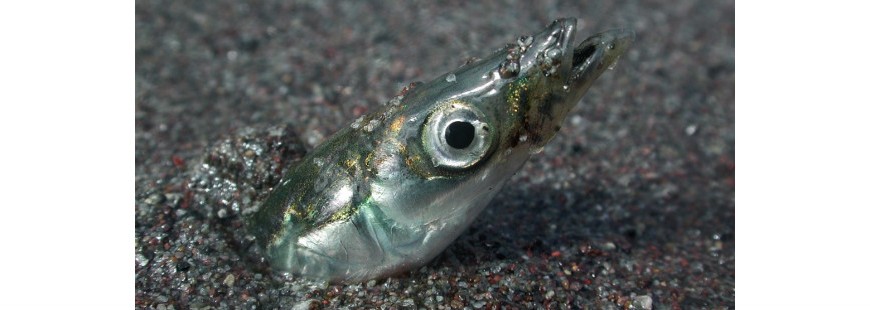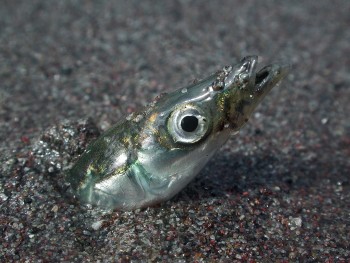This blog post appears as part of our “Focus on Forage Fish” series, which highlights the importance of managing prey species for ocean ecosystems.
Well into fall, the sun is setting sooner, the nights are getting colder and the fish are getting fewer. Winter is not far away, and with it, ecosystems start to dramatically slow down.
It’s evident in about every aspect of our terrestrial and aquatic species. Can you imagine how well humans would survive the winter these days if we didn’t have grocery stores to go to? I don’t think we’d have a population problem. The noble species on our planet plan for the winter time and to some extent, we do too; our vegetables are canned and our fish are frozen. It’s not that easy for our baitfish.
With the drastic drop-off of the photoperiod, plant life will grow much slower, so therefore, so will the rest of the food chain. It couldn’t be more evident than the annual growth rings of trees and the scales of salmon. Like a tree, salmon lay down layers of scales over the course of the year. Look at a salmon scale under a microscope and you can not only tell when the summer growth occurred (the growth rings are spread far apart) but you can also tell whether or not the fish is wild or hatchery. Hatchery fish have more uniform growth rings because they are fed regularly while wild fish have to forage harder to get a good meal (and growth) in the winter.
It’s no different for sea birds. Pelicans are surface feeders and therefore, need their prey to be close to the surface to be successful. Well, we see most baitfish headed to the deep this time of year and the pelicans are headed south. We’re many months away from productive waters again; the upwelling of spring time will be a welcome time for the ocean ecosystem.
It’s pretty hard for us to realize how hard nature really has it in the winter; that’s when I typically bulk up from the Thanksgiving turkey and the Christmas prime rib, oh yea, New Year’s French onion soup! Can you imagine how big our salmon would be if they were able to eat like us in the winter time?
Managing forage fish is a whole other story; can you really call it managing when we don’t know how many of them there are? Stock assessments are an expensive and tedious task that in most years, we don’t have the luxury of utilizing. The last stock assessment for anchovies for example, was done in the 1970’s; seem a bit out of date?
For this reason, we have to seriously consider “managing” our forage fish prey base very conservatively. It may be by sheer luck that there aren’t a lot of targeted fisheries for forage fish off of the Oregon and Washington coasts. Herring at one time was a pretty big commercial fishery in Newport Bay in Oregon. The stocks went cyclical but likely became pretty depressed from over-harvest and habitat degradation. I’m not exactly sure if there is still a directed commercial fishery for them in Yaquina Bay in Newport but no matter if it’s sport or commercial, in February, when the fisheries take (or took) place, there was intensive effort for them… wait for it… yes, during spawning season! This may not be the best utilization of a resource such as herring.
With a directed sardine season now closed and signs that the northern anchovy population is getting scarce (humpback whales feeding in the lower Columbia River for example), it is high time that we develop a strong strategy for managing the ups and downs of these fish. Most importantly, we need to make sure we’re ahead of the curve before we overfish a dwindling stock of fish.
Herring, anchovies, sardines and some smelts are examples of managed forage fish. While they do have additional management measures in place to keep fisheries from going un-checked, without stock assessments, how do we really know how much of the biomass we are really taking out of the ocean?
Saury, Pacific sandlance and some species of squid are unmanaged forage fish that until recently, might have had directed fisheries on them that could have easily got out of hand. The Pacific Fishery Management Council however recently made it much more challenging for offshore fleets to harvest these species without a long, drawn-out procedure. With the growing thirst for a protein source to feed aquaculture and livestock feed lots, this was a great pro-active approach to keep these species where they belong, feeding the commercial and sport-important stocks of fish that fuel our coastal economies.
We may be a long ways out from effectively managing these critical species, but there are important measures for management in place through the Magnuson-Stevens Act. With reauthorization up this year, however, there can always be improvements made. Stay tuned to our blog as we keep our readers informed about public processes that allow us to shape the future of our own fisheries. If there are not “groceries” in the store, there’s no sense in going shopping.
Photo credit: “Ammodytes hexapterus” by Mandy Lindeberg, NOAA/NMFS/AKFSC




Pingback: Focus on Forage Fish | Marine Fish Conservation Network
Next time I read a blog, I really hope that it doesnt disappoint me up to this one.
After all, I understand it had been my choice to read, but I actually thought
youd have anything interesting to say.